Are White Women Easy to Get in Bed?
Sexual Behavior and Attitudes among White, Black, Latinx, and Asian College Students
In her 2017 book American Hookup, Lisa Wade says, based on what some students of color told her, that "in some ways, hookup culture is a white thing." In this blog post, we use data from an online survey from over 20,000 American students at 21 colleges and universities to explore what, if any, differences in sexual behavior or attitudes about sex exist between White, Black, Latinx, South Asian, and East Asian students.
What We Did
We used data from the Online College Social Life Survey (OCSLS), collected by Paula England between 2005 and 2010, to compare White, Black, Latinx, East Asian, and South Asian students. (We call these racial groups for brevity, realizing that Latinx is sometimes considered an ethnicity rather than a race.) We examined racial differences separately for men and women and compared groups on attitudes and behaviors. The percents, means, or medians in the graphs below are regression-adjusted to remove any part of racial differences that stems from group differences in age, immigrant status, mother's education, whether their parents are still together, school, height, and body mass index (BMI). For more details on our models, see the Technical Appendix at the end of this post.
Some Attitudes Show Almost No Racial Differences
On some values and aspirations, racial groups seem remarkably alike. As the two graphs below show, between 90% and 93% of those in every race/gender group of both men and women say they want to marry, and between 89% and 96% of every group want children.
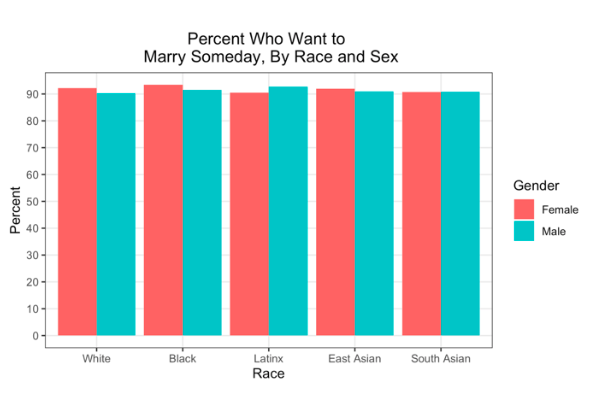

Racial groups also differ little in their ideas of the best age to do these things, with the average age seen as ideal for marriage between 25 and 28 for all groups and the average ideal age for having a first child between 27 and 29. Also, racial groups have in common that, in each group, compared to women, men see a slightly higher age as appropriate for themselves to take on these roles.

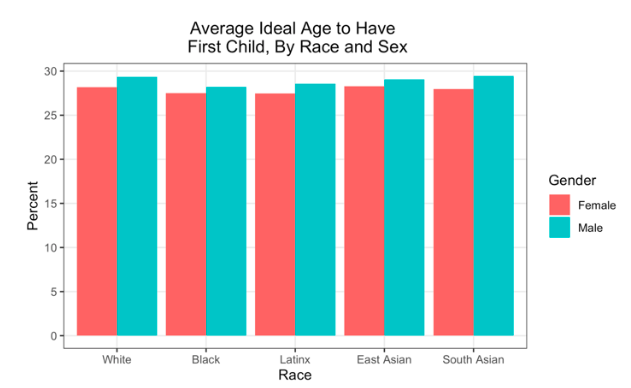
One attitude about hooking up also shows virtually no racial differences: in all groups, approximately 70%-75% of men and women say they would be less interested in a relationship with a person who hooks up a lot, as this graph shows.

Racial Group Differences in Attitudes About Sex
Some attitudes show significant differences by race. One question asked students how much they agree with this statement: "I would not have sex with someone unless I was in love with them." In every racial group, more women than men agree. Focusing on racial differences, Whites and Blacks are similar in their response, and these two groups are most positive about sex without love, as the graph below shows. Latinx students are more conservative. Asian students are the most conservative in their belief that sex requires love. As the graph shows, among women, white and black women are equally liberal, with only 49% agreeing that sex requires love. A larger 59% of Latinas, 64% of East Asian women, and 76% of South Asian women agree.
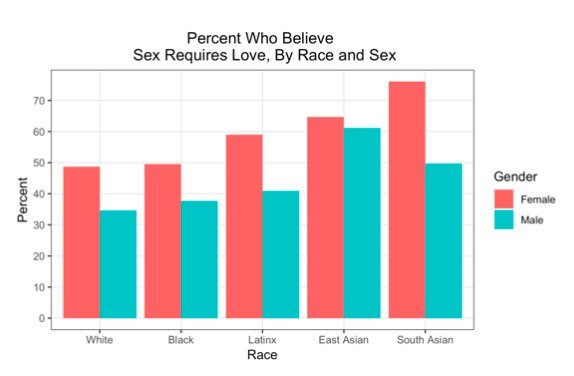
Those who believe sex requires love presumably disapprove of casual sex but might think that sex among students in relationships is okay. A more conservative standard is disapproving of any sex before marriage, even in a serious relationship. The graph below shows that South Asians are the most conservative in believing that premarital sex is wrong, while Whites are the most liberal, with Latinx students very close to Whites. Unlike beliefs about whether love is necessary for sex, where Whites and Blacks were very close to each other, these beliefs about whether premarital sex is wrong show Black students to be substantially more conservative than Whites and Latinx students. On the issue of premarital sex, Blacks are closer to the conservative views of Asians, who are the most conservative.
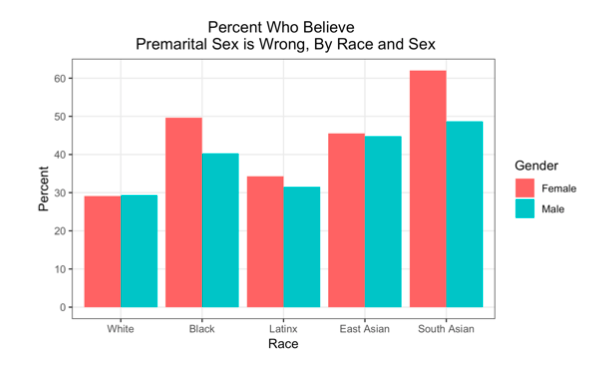
Racial Group Differences in Sexual Behavior
Now we move to behavior, starting with the simplest measure—the percent of students who are still virgins. In our sample, in which the average student was in their second year of college, South Asians have the highest proportion of virgins: 66% of women and 50% of men had never had intercourse. The group with the next highest rate is East Asians. Whites, Blacks, and Latinx students all have lower rates of between 21% and 34% virgins.
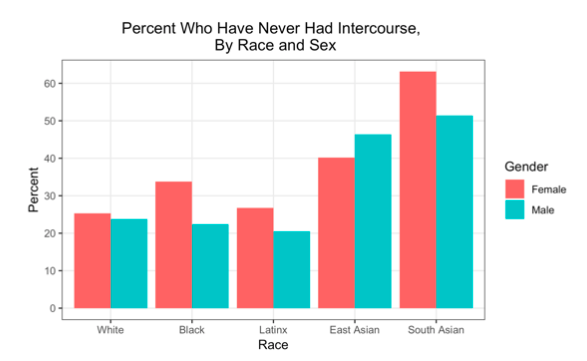
Next, we look at the number of hookups since the start of college each group reported. We use the median (the number that the man or woman at the 50thpercentile had) rather than the mean (the average) because the median is less influenced by the few students who reported extremely high numbers of hookups. Among men, Asians have the lowest number of hookups, with a median of one hook up, Latinx men are next with a little above two, and Whites and Blacks are the highest with almost identical medians at approximately three hookups. Among women, we Black and East or South Asian women have hooked up little, Latinx women are in the middle, White women have hooked up the most. While this shows that hooking up is most prevalent among whites, it also shows that it is certainly not only a "white thing." Indeed, among men, as we saw it is done about the same amount by Black and White men.
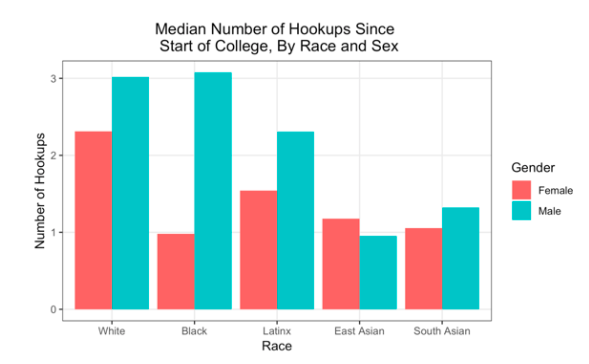
Of course, knowing the rate at which students are hooking up does not tell us how much they have casual intercourse, because not all hookups involve intercourse. As students define the term "hookup," a hookup may involve little or even nothing more than making out, and these data show that about 40% of hookups involve intercourse. To get at whether students had had casual intercourse, the survey asked if they had ever had sex outside of an exclusive relationship. The question didn't clarify what was meant by "sex." However, there is lots of qualitative evidence that heterosexual students usually take the term to mean intercourse, whereas a majority of what they call hookups do not involve intercourse.
As the next graph shows, Asians are the least likely to have had sex outside an exclusive relationship. This is partly a reflection of the fact that many haven't had intercourse at all, as we saw above. Black, White, and Latinx students have had more casual intercourse, and within-sex, race differences are fairly small in these three groups. In every group other than East Asians, men are more likely to report sex outside a relationship than women.
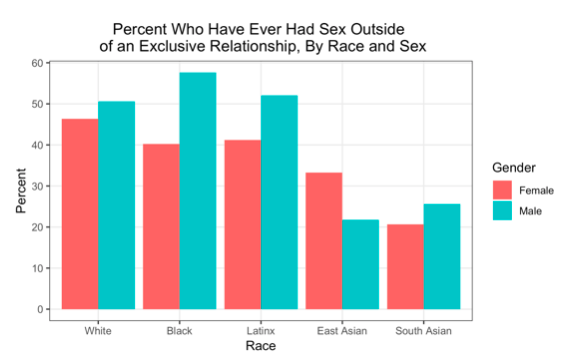
Another behavioral indicator is the number of partners with whom one has ever had intercourse. In this analysis, virgins count as having zero partners, and we limited the count to the number of partners of the other sex, ignoring any same-sex partners. We examine medians rather than averages because there are some extreme outliers with many partners, which affect means more than medians. The graph below shows that among both women and men, Asians have had the least number of partners. Among women, there is little difference between Whites, Blacks, and Latinas, all of whom have had between 1.5 and 2 partners. Among men, however, Blacks have substantially more than other men, with a median slightly more than 4, compared to between 2 and 2.5 for Whites and Latinx men, and less for Asian men.

Explaining Racial Differences and Race-Gender Intersections
We have shown that racial groups are virtually identical on whether and when they want to marry and have children.However, there are some group differences in attitudes about students having sex, and in their sexual behavior.
Where we see differences, Asians, especially South Asians, appear the most conservative in attitudes and behavior, Latinx students are in the middle, and either Whites or Blacks are generally the most permissive, depending on the issue. In this blog post, we can't fully answer the complicated questions of what causes these differences, but we offer some ideas, with some data to back them up.
Over 95% of both the East Asian and South Asian students in our study are either first- or second-generation immigrants – that is, either they were themselves born outside the U.S., or one or both of their parents were. We speculate that the relatively conservative attitudes and less active sexual behavior of Asians result from the influence of their immigrant parents from Asia. Fewer, but a still high 82%, of the Latinx students in our study are first- or second-generation immigrants, so this explanation may apply somewhat to them as well. By contrast, only 16% of Whites and 35% of Black students in the study are immigrants or had an immigrant parent. (See the technical appendix for more details on this.)
As for differences between Blacks and other racial groups, the patterns differ strongly by gender. As many race and gender scholars have argued, an intersectional approach is often needed when the way race affects men and women is very different. Let us start with men. Black men have had more sexual partners than White or other men. What explains this? Prior research has shown that youth of any race who grow up in poverty or with less educated parents are more likely to have first intercourse earlier and Blacks are especially likely to grow up disadvantaged. Consistent with this, past research on the age of sexual debut among US adolescents, has shown that Black youth have an earlier age at first intercourse than Whites, which is likely to lead to more sexual experience by the age of most of the college respondents. (The survey question asks about number of partners ever, not only during college, so having started during or before high school could lead to a higher lifetime number.)
The difference between White and Black men's median partners is 1.9—with Black men having a median of 4.2 and White men 2.3 partners. To test how much of this is explained by Black men having had an earlier age at first intercourse, we re-estimated the regression analysis controlling for this factor and created adjusted medians assigning the age at first intercourse for the sample as a whole to all races of men. The new adjusted median number of partners is only .7 apart rather than 1.9 apart, implying that about two-thirds of the gap is explained by differences in age at first intercourse. Thus, the White-Black differences among men may reflect less about different behavior at college and more about the early effects of disadvantage leading to early first sex.
However, if the explanation we offered for Black men were just about socioeconomic disadvantage, we would expect to find it applicable to Black women too. Instead, we found that Black women students are significantly more likely to be virgins than White women, they have had about the same number of intercourse partners as White women, and they have had substantially fewer hookups than either White women or Latinas. Moreover, they are more likely to think premarital sex is wrong than any race-gender group other than South Asian women. Why are Black women more conservative than other racial groups on many indicators, while Black men are more liberal? We suggest two possible explanations. It may be in part because Black women are aware of stereotypes of Blacks as hypersexual, and, given the gendered double standard that shames women more than men for casual sex, black women may feel the responsibility to behave in a way that doesn't reinforce racial stereotypes usually seen as pejorative. A second possible explanation for the fact that Black women are more likely to be virgins and have fewer hookups is that Black women may be less sought after as partners than women of other races, a race-gender-specific bias in the erotic hierarchy.
Technical Appendix: Data, Measures, and Statistical Procedures
Data
We used data from the Online College Social Life Survey (OCSLS). The OCSLS surveyed over 20,000 students from 21 four-year colleges and universities between 2005 and 2011. The colleges and universities where the survey was administered were both private and public.
A limitation of the OCSLS survey is that participants surveyed did not come from a probability sample. However, because the instructors in the courses hosting the survey gave students extra credit, participation in these classes was nearly 100%. Thus, any non-representativeness of the sample is likely caused by the schools chosen and the kinds of students in the hosting courses, not who decided to participate within classes. Also helpful to the representativeness of the sample is the fact that, although the hosting classes were mostly sociology, only approximately 10% of respondents were sociology majors.
Students were asked their race or ethnicity, which we used to divide them into White, Black, Latinx, East Asian, or South Asian. (Students in other groups, such as Native American, were not used because other groups were too small for reliable analyses.)
The outcome measures used are questions about sexual behavior and attitudes.
Attitudes
We used the following questions (see bullets below) to tap attitudes and values regarding sex.
- If a man and a woman have sexual relations before marriage, do you think it is wrong?
For this question, we divided students into two groups—those who chose "not wrong at all," the most permissive answer, and those who took the more restrictive view that premarital sex is 'always,' 'almost always,' or 'sometimes' wrong.
- If someone has hooked up a lot, I'm less interested in this person as a potential girl/boyfriend.
- I would not have sex with someone unless I was in love with them.
For the two questions above, response categories were; strongly agree, agree, disagree, or strongly disagree. We divided the responses into a more permissive group who disagreed or strongly disagreed and a more restrictive group who agreed or strongly agreed.
- Do you want to get married in the future?
Respondents answered yes, no, don't know, or already married. We deleted those already married then dichotomized into those who said yes, versus those who said no or don't know.
- Do you want to have children (or more children) in the future?
Respondents answered yes or no.
- How old would you ideally like to be when you get married?
- How old would you ideally like to be when you have children (or more children)?
Respondents who wanted to get married or have children gave an exact age for the two questions above.
Behavior
Regarding sexual behavior and hooking up, students were asked:
- How many people have you had intercourse with?
- Have you ever had intercourse outside of an exclusive relationship?
Responses were yes and no.
- Since you started college, how many people have you hooked up with in the case where you were not already in a romantic relationship with the person but you did know him or her?
- Since you started college, how many people have you hooked up with whom you didn't know before that night?
The numbers students gave for the two kinds of hookups above were added together to get their total number of hookups.
Models
The graphs above show regression-adjusted averages, medians, or percents. That is, these percents or numbers are predicted values from a regression predicting the attitude or behavior from: age (entered linearly), immigration status (categorized into whether the student was a first-generation immigrant, had at least one parent who was an immigrant, or was not an immigrant and did not have a parent who was), respondent's mother's education (high school only, less than high school, some college, bachelor's degree, graduate degree), whether respondent's parents are still together, indicators for school attended, height, and body mass index (BMI).
Using the regression equations, for each outcome we predicted a mean, median, or percent for each racial group, using an average marginal effects approach, such that each racial group was assigned the whole sample distribution of all control variables, thus giving each group the same distribution on these controls, and thus "controlling for" these factors. In the case of predicted averages and percents, the regression was an OLS regression. Where the variable was a dichotomy, this OLS is a linear probability model. In the case of medians, we used a conditional quantile regression. Separate regressions were done for men and women. Interestingly, racial group differences were very similar to those found in simple descriptive statistics on each group calculated with no regression adjustment.
In the post, we suggest that having immigrant parents from nations with somewhat more conservative sexual norms may explain the more conservative beliefs and behavior of South and East Asian students, and, to a lesser extent of Latinx students. The attentive reader may wonder why we say this when our model includes immigration status as a control variable, implying that the differences we find "hold immigration status constant." Our model accomplishes this only if we assume that the effect of immigration status is constant across groups (technically, that there is no interaction between race and immigration status). However, our earlier posts Do Immigrants Have More Conservative Sexual Attitudes Than Other College Students? and What Does Studying College Sex Tell Us About Immigrant Assimilation? showed that this is not true.
Among whites, immigrant status has little effect on sexual attitudes or behavior, perhaps because white immigrants are mostly Canadians, Europeans, and Australians, and the sexual norms in these countries are not so different than those in the United States. Since Whites are the most numerous in the sample, the effects of immigration status that are used in the regression adjustment in this post, which are for the sample as a whole, are dominated by the small effects for whites. Thus, the model does not adequately adjust for the effect of having immigrant parents on Asian and Latinx students, leaving open the possibility that this may be the explanation for their more conservative sexual behavior.
In one supplementary model discussed above, to explore how much of the Black/White difference among men in number of intercourse partners is explained by an earlier age at first intercourse, we run an additional quantile regression for men predicting number of partners from all the variables in all the regressions discussed above, plus age at first vaginal intercourse (represented with indicator variables for "14 or younger," "15 to 19," and "20 or older," which included virgins). We then used the regression results to predict number of partners separately for Black and White men assuming they each had the sample-wide distribution on age at first intercourse. (We also assumed they had the sample-wide mean on other variables, but that adjustment was already reflected in the graphs shown.)
Data Access
Researchers who wish to use the OCSLS data can contact Emma Mishel at ekm331@nyu.edu for information on how to download the data.
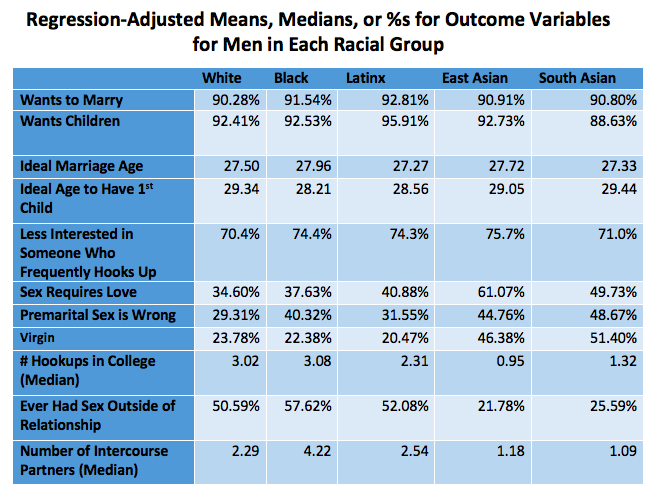
*Note: Numbers shown are means except when indicated that they are medians. In the case of dichotomized variables, the means (X100) are the percent in the category indicated by the variable name.
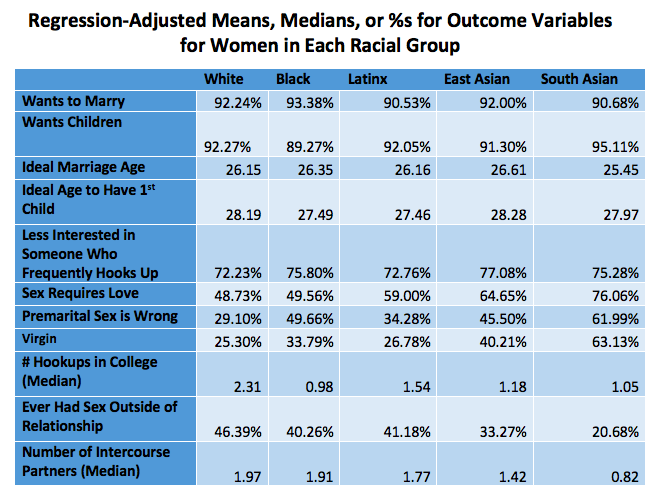
*Note: Numbers shown are means except when indicated that they are medians. In the case of dichotomized variables, the means (X100) are the percent in the category indicated by the variable name.
Emma Patton is an undergraduate Sociology major, Paula England is Silver Professor of Sociology, and Andrew Levine is a doctoral student in Sociology. All are at New York University.
Source: https://contexts.org/blog/sexual-attitudes-among-college-students-similarities-between-white-black-latinx-and-asian-students/
0 Response to "Are White Women Easy to Get in Bed?"
Post a Comment